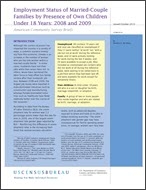Employment Status of Married-Couple Families by Presence of Own Children Under 18 Years: 2008 and 2009
Employment Status of Married-Couple Families by Presence of Own Children Under 18 Years: 2008 and 2009
Introduction
Although the current recession has impacted the country in a variety of ways, a common scenario emerging from this economic climate is an increase in the number of women who are the sole worker within a married-couple family.1 In some cases, husbands have lost their jobs while their wives have not. In others, wives have reentered the labor force to help offset lost family income after their husbands’ job loss. Between 2008 and 2009, the largest job losses were reported in male-dominated industries such as construction and manufacturing, whereas female-dominated industries such as healthcare have fared relatively better over the course of the recession.2
According to data from the Bureau of Labor Statistics (BLS), the unemployment rate for women was 2.2 percentage points lower than the rate for men in 2009, one of the largest unemployment rate gender gaps reported by BLS.3 Reinforcing this difference in unemployment rates is the increasing likelihood that women possess education levels, such as advanced degrees, required to attain and hold on to jobs in today’s evolving economy.4 The unemployment rate gender gap may have consequences for family spending power since, on average, women earn less than men do.5 Given the rising costs of education, childcare, and healthcare, married-couple families with children will face an even greater strain on their family budgets.
__________
1 Bureau of Labor Statistics, Employment Characteristics of Families, Economic News Release, Table 4. Families with own children: Employment status of parents by age of youngest child and family type, 2008-09 annual averages.
2 Hipple, Steven F., “The Labor Market in 2009: Recession Drags On,” Monthly Labor Review, March 2010, Vol. 133, No.3, pp. 3–22 and U.S. Census Bureau, American Community Surveys, 2008 and 2009, table S2403.
3 Bureau of Labor Statistics CPS Annual Averages: <bls.gov/cps/cpsaat2.pdf>.
4 For example, between 2008 and 2009, the number of females over the age of 25 with a graduate or professional degree increased 3.7 percent while the number of male graduate and professional degree holders over the age of 25 remained unchanged (U.S. Census Bureau, American Community Surveys, 2008 and 2009, author’s tabulations). Also see McQueen, M. P., “Better Education Shields Women from Worst of Job Cuts,” The Wall Street Journal, February 12, 2010, at <online.wsj.com/article/NA_WSJ_PUB:SB10001424052748703389004575033762482114190.html> and Bureau of Labor Statistics, Occupational Outlook Handbook, 2010–11 Edition, <www.bls.gov/oco/oco2003.htm>.
5 “Men’s and Women’s Earnings for States and Metropolitan Statistical Areas: 2009,” American Community Survey Briefs, <www2.census.gov/library/publications/2010/acs/acsbr09-03.pdf>.
Others in Series
Publication
Publication
Publication




